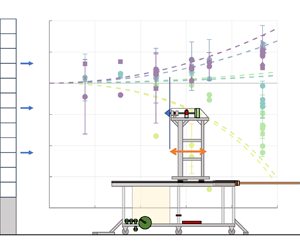Article contents
Power-generation enhancements and upstream flow properties of turbines in unsteady inflow conditions
Published online by Cambridge University Press: 04 July 2023
Abstract

Energy-harvesting systems in complex flow environments, such as floating offshore wind turbines, tidal turbines and ground-fixed turbines in axial gusts, encounter unsteady streamwise flow conditions that affect their power generation and structural loads. In some cases, enhancements in time-averaged power generation above the steady-flow operating point are observed. To characterize these dynamics, a nonlinear dynamical model for the rotation rate and power extraction of a periodically surging turbine is derived and connected to two potential-flow representations of the induction zone upstream of the turbine. The model predictions for the time-averaged power extraction of the turbine and the upstream flow velocity and pressure are compared against data from experiments conducted with a surging-turbine apparatus in an open-circuit wind tunnel at a diameter-based Reynolds number  $Re_D = 6.3\times 10^5$ and surge-velocity amplitudes up to 24 % of the wind speed. The combined modelling approach captures trends in both the time-averaged power extraction and the fluctuations in upstream flow quantities, while relying only on data from steady-flow measurements. The sensitivity of the observed increases in time-averaged power to steady-flow turbine characteristics is established, thus clarifying the conditions under which these enhancements are possible. Finally, the influence of unsteady fluid mechanics on time-averaged power extraction is explored analytically. The theoretical framework and experimental validation provide a cohesive modelling approach that can drive the design, control and optimization of turbines in unsteady flow conditions, as well as inform the development of novel energy-harvesting systems that can leverage unsteady flows for large increases in power-generation capacities.
$Re_D = 6.3\times 10^5$ and surge-velocity amplitudes up to 24 % of the wind speed. The combined modelling approach captures trends in both the time-averaged power extraction and the fluctuations in upstream flow quantities, while relying only on data from steady-flow measurements. The sensitivity of the observed increases in time-averaged power to steady-flow turbine characteristics is established, thus clarifying the conditions under which these enhancements are possible. Finally, the influence of unsteady fluid mechanics on time-averaged power extraction is explored analytically. The theoretical framework and experimental validation provide a cohesive modelling approach that can drive the design, control and optimization of turbines in unsteady flow conditions, as well as inform the development of novel energy-harvesting systems that can leverage unsteady flows for large increases in power-generation capacities.
JFM classification
- Type
- JFM Papers
- Information
- Copyright
- © The Author(s), 2023. Published by Cambridge University Press
References
- 4
- Cited by





